Grand Prix > 2007 Grand Prix > Grand Prix of Japan > Review
|
|
02 Oct,2007 (Tue)
Thank you for your support over the weekend. After a 30–year absence, the F1 World Championship Series has returned to Fuji Speedway. With the invaluable help and cooperation of local government and citizens, the F1 Japanese Grand Prix finally found its way back to the Fuji Speedway. We began our Fuji Project in May of this year, preparing for this day when we would be able to meet the lofty expectations of our fans. Here is my report from the F1 Japanese Grand Prix, held for the first time in 30 years at the Fuji Speedway.
Fuji Special: New floor, rear wing, and turning vanes
The Fuji Speedway circuit consists of a long straight and a technical infield section, making it challenge to find the right aerodynamic settings. We conducted simulations to find the best aerodynamic package for quicker lap times around the circuit, testing what we believed to be an optimal package last week during the joint testing session at Jerez. After confirming the performance during testing, we brought this new package with us to Fuji Speedway.
More particularly, we put in a redesigned floor (including diffuser), rear wing, and turning vanes. We also changed the front tire wheel covers to a non-rotating design.
Friday: Jarno settles in at P4, despite setup problems
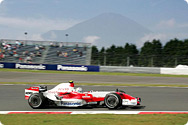 The first day of the F1 Japanese Grand Prix at Fuji was blessed with clear weather. Panasonic Toyota Racing came to its home grand prix featuring a brand new specification for floor, rear wing, and turning vanes.
The first day of the F1 Japanese Grand Prix at Fuji was blessed with clear weather. Panasonic Toyota Racing came to its home grand prix featuring a brand new specification for floor, rear wing, and turning vanes.We finally reached the first day of the Japanese Grand Prix weekend.Looking solely at Jarno’s (Trulli) P4 on the time charts during the second practice session on Friday, one would think that we started the weekend in a pretty good position. However, it took us some time to find the right setup. Normally, you expect understeer going into a corner and oversteer on the corner exit. But on Friday we were having oversteer issues in the middle of the corners. We made adjustments to the weight distribution and front/rear spring balance to dial in our setup, making no downforce level changes at all between the morning and afternoon sessions.
Both drivers reported back that our new aero parts were working fine, but Jarno's best time of 1m19.711s was slower than we had predicted based on our Friday simulation time. Considering track grip, I think we could have gone a bit faster, so I can’t say our performance Friday was completely satisfactory.
Unable to fully draw out the performance of our extreme weather tires
Qualifying turned out to be a disappointment, especially considering how we ran during free practice on Friday. Our performance in the rain during Saturday morning practice was by no means poor. Normally, we check each component on the car and then bring them back into the pits, but since we confirmed that everything was running well during our installation lap, we left both cars out on the track. When the red flag came out right away, Ralf (Schumacher) had yet to pass the control line, and Jarno had to stop after only one lap. Even so, the feel of the cars seemed to be fine, and we were looking forward to qualifying in the afternoon.
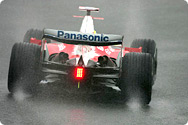
A change in the weather, and a rainy qualifying session. Ralf made it through the first period, but started P16 on the race grid, unable to continue to Q2 because of collision damage to his car.
Mistakes and car trouble keep both cars out of the points. Looking for a much stronger race next year
Still having high hopes for the race, our results were very disappointing result, especially because it was in front of the large number of fans who packed the stands in the rain. No doubt, the stormy weather played a part in our inability to demonstrate our true power, but we can’t use that as an excuse when all teams race under the same conditions.
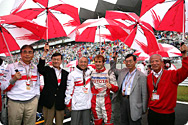
Many special guests cheered on the drivers, including Tsutomu Tomita, former leader of Panasonic Toyota Racing and current president of Fuji Speedway.
Jarno’s spin behind the safety car happened when he accidentally touched the paddle shifter, shifting down as he was moving the wheels back and forth to generate some tire heat. Since the error cost him track position, we hurriedly changed our race strategy. With the safety car out on the course for a long time, we anticipated a weather–shortened race. Accordingly, we fueled Jarno’s car with enough fuel for 75% of the total race distance, and sent him out on the course. Ultimately, though, the race went the official distance, with the safety car only coming out once more the whole time. Without enough fuel to finish the race, Jarno had to come back into the pits during the final stint.
Getting a full tank of fuel on lap 18, Jarno wasn’t able to increase his pace. When Ralf came in for his first pit stop on lap 28, we decided not to fill his tank to the top. While I don’t believe the strategy itself was a mistake, Ralf experienced electrical system problems that affected his wireless equipment, preventing him from coming into the pits quickly after the safety car came out for the second time, and costing us position on the track.
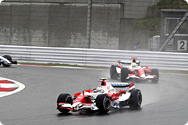
Race day was rainy–just like the 1976 race at Fuji. While the team expected to finish high in the standings, a spinout and electrical system problems prevented the team from seizing its chance.
Ralf’s electrical system problems soon became much more serious. By the time he came in for a third pit stop, the race was essentially over. But everyone on the team was united in their desire to fight to the end, and the mechanics came together and worked incredibly hard to get Ralf’s car back out on the course before the end of the race. Unfortunately, the rough race had left quite a bit of shrapnel on the track, and in the end Ralf finished the race in the pits with a punctured tire.
To finish the F1 Japanese Grand Prix like this–a Grand Prix for which we had such high goals–was truly disheartening. But the season isn’t over, yet. I want you to know that we will give our all, fighting until the very end. Next year, we’ll come back to Fuji Speedway a stronger team. And we hope you’ll continue to cheer us on!
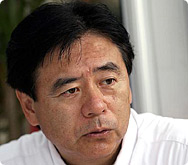
Noritoshi Arai at Fuji Speedway. It was a rainy, frustrating race, with the team unable to show their true strength. Panasonic Toyota Racing is looking for a comeback at the next race–the Chinese Grand Prix.